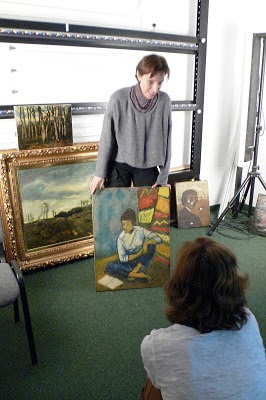Tuesday, August 13, 2013 -  art destruction,Kunsthal Rotterdam,negotiate,painting analysis
art destruction,Kunsthal Rotterdam,negotiate,painting analysis
 No comments
No comments
 art destruction,Kunsthal Rotterdam,negotiate,painting analysis
art destruction,Kunsthal Rotterdam,negotiate,painting analysis
 No comments
No comments
Kunsthal Rotterdam Art Theft: Defense Lawyer claims five of the seven paintings can be returned if trial is moved from Romania to The Netherlands (Trial in Bucharest Suspended until September 10)
 |
| Lucian Freud, Woman with Eyes Closed, 2002 |
by Catherine Sezgin, ARCA Blog Editor
The good news is that the alleged thieves have offered to exchange paintings stolen from Kunsthal Rotterdam if their courtroom is moved from Romania to The Netherlands; the bad news is that they are reputedly only offering to produce five of the seven paintings. Despairing news is that Romanian art experts announced yesterday that they found paint pigments only manufactured prior to World War II from the ashes of a stove that a mother of one of the alleged thieves confessed to use to destroy the evidence (paintings) against her son.
We last ran a post about this celebrated theft with the article in The New York Times by Andrew Higgins ("A Trail of Masterpieces and A Web of Lies, Leading to Anguish") in which the reporter described the "stove" as one "used to heat water for the bathroom and the sauna" and described it as "barely a foot wide and far too small to contain what would have been a bulky bundle of canvas and wood". Previous ARCA blog posts described the seven paintings stolen from the Triton Foundation.
 |
| Picasso's Head of a Harlequin, 1971 |
On August 8, an article in [Daily]Mail Online ("Despair etched on art expert's face as he confirms fragments of artwork found in oven ashes were those of stolen paintings by old masters" by Mark Duell and Steve Nolan) showed the "sadness" of Ernest Oberlander-Tarnoveanu, manager of Romania's National History Museum and Gheorghe Niculescu, head of a team of investigative experts, at a news conference in Bucharest. Oberlander-Tarnoveanu reportedly said that 'a probe found traces of 'very old' yellow arsenic, which painters said has not been in common use since Second World War because of its toxicity.'
These are the dates of the stolen paintings: Lucian Freud's Woman with Eyes Closed, 2002; Paul Gauguin's Woman Before a Window, 'The Fiancée', 1888; Henri Matisse's Reading Woman in White and Yellow, 1919; Jacob Meyer De Haan's Self-Portrait against Japonist Background, 1889-1891; Claude Monet's Waterloo Bridge, London, 1901; Monet's Charing Cross Bridge, London, 1901; and Pablo Picasso's Head of a Harlequin, 1971. Only two of the paintings (Freud, Picasso) were painted after World War II.
DutchNews.nl reported August 8 in "Police 'fail to notice' art theft, allowing Kunsthal thieves to escape" that "AD" (A Dutch Media agency) reported police blunders facilitated the getaway of the thieves -- based on 'legal documents and an interview with a lawyer for the defendants': 'The paper says police, alerted by the alarm, carried out an inspection but failed to realise the museum had actually been broken into because the thieves had closed the door behind them.' Other claims include gaps on the walls viewed as changes in the exhibition and a police officer waving to one of the suspects after the robbery. Here in an interview Dutch security expert Ton Cremers cited negligence at Kunsthal Rotterdam.
Finally, on the first day of the trial of the jailed suspects in Romania, Anna Holigan reports in a video from The Hague on BBC News ("Dutch art theft suspects offer paintings for deal") that Romanian art experts fear three to four of the paintings may have been destroyed. However, BBC reports:
Forensic experts have so far refused to say definitively whether or not the burnt remains were from stolen paintings.... The trial of Radu Dogaru and his five alleged accomplices -- one of whom is still on the run -- was opened and adjourned by the Romanian court until 10 September.... One of the lawyers said their clients had offered to return five of the paintings, with no mention of the remaining two. Another lawyer, Maria Varsii, said: It is more likely the paintings are intact. My client says they can be handed over to the Dutch authorities. In exchange, they want to go on trial in the Netherlands.... The Rotterdam paintings came to light some months [after the October 16 theft] later when Mariana Dragu, an art expert at Romania's National Art Museum, was asked by a friend to examine some artworks he was planning to buy. She said she called the prosecutor's office when she realised she was looking at the stolen originals. A few months later, three Romanian men were arrested on suspicion of involvement, including Radu Dogaru. It was following her son's arrest that Mrs. Dogaru allegedly burned the artworks at her home in the village of Carcaliu, in the Danube Delta region of eastern Romania.


